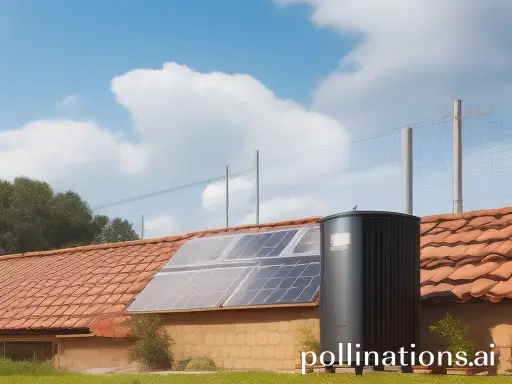Embark on an enthralling journey into the realm of solar heaters and the limitless potential of renewable energy. Our all-inclusive guide will walk you through the entire process, starting from evaluating whether your home is suitable for solar heaters to acquiring the required permits. Uncover the countless advantages, delve into various types of solar heaters, and obtain valuable knowledge about maintenance needs.
Let’s join hands in embracing the power of the sun and forging a pathway towards a more sustainable future.

Assessing Your Home’s Suitability for Solar Heaters
Evaluating Roof Space and Orientation
When considering solar heaters, it’s important to evaluate your home’s roof space and orientation. You need enough space on your roof to accommodate the solar panels. Ideally, a south-facing roof receives the most sunlight throughout the day, but east and west-facing roofs can also work.
Checking for Shading Issues
Shading can significantly impact solar heater performance. Before installation, check for potential shading from trees, buildings, or other obstructions. Even partial shading can reduce efficiency, so make sure the panels will receive maximum sunlight exposure.
Determining the Solar Resource Potential
To determine the solar resource potential, consider factors like your geographical location, climate conditions, and average sunlight in your area. The angle and tilt of your roof also matter. Consult a solar professional or use online solar mapping tools to accurately assess your home’s solar resource potential.
By evaluating roof space and orientation, checking for shading issues, and determining solar resource potential, you can assess your home’s suitability for solar heaters. Considering these factors will help you make an informed decision and maximize the benefits of solar energy.
Expert Tip: Maximize solar heater benefits by evaluating roof space, checking for shading, and determining solar resource potential.Choosing the Right Solar Heater System
Understanding Different Types of Solar Heaters
When choosing a solar heater system, it’s important to understand the different types available. There are active and passive solar heaters. Active solar heaters use pumps or fans to circulate fluid or air, while passive solar heaters rely on natural convection to distribute heat. Each type has its own advantages and considerations.
- Active Solar Heaters: These systems actively circulate fluid or air. They can be further classified into:
- Liquid-Based Systems: These systems use liquid, such as water or antifreeze, to transfer heat from the solar collectors to the storage tank or directly to the house.
- Air-Based Systems: These systems use air as the heat transfer medium. They circulate it through solar collectors and then distribute the heated air throughout the house.
- Passive Solar Heaters: These systems rely on natural convection to distribute heat. They can be categorized as:
- Direct Gain Systems: These systems absorb and store solar heat directly in the living space, such as through south-facing windows or a sunroom.
- Indirect Gain Systems: These systems use thermal mass, such as a wall or floor, to absorb and store solar heat. The heat is then released gradually into the living space.
- Thermosiphon Systems: These systems use natural convection to circulate fluid between the solar collector and the storage tank. They don’t require pumps or fans.
Selecting the Appropriate Size and Capacity for Your Home
Choosing the right size and capacity for your solar heater system is crucial for optimal performance and energy savings. Factors to consider include:
- The amount of hot water or space heating required in your home.
- The climate and solar resource available in your area.
- The orientation and tilt of your solar collectors.
- The efficiency and performance ratings of the system.
It is recommended to consult with a professional solar installer to assess your specific needs and receive guidance on the appropriate size and capacity for your home.
Considering Budget and Available Incentives
Before making a final decision, consider your budget and explore available incentives for solar heater systems. While solar heaters can provide long-term energy savings, the initial investment can vary depending on the system type and size.
Research local, state, and federal incentives, such as tax credits or rebates, that can help offset the upfront costs. Additionally, consider the potential return on investment over time and the overall value that a solar heater system can bring to your home.
| Factors to Consider | Active Solar Heaters | Passive Solar Heaters |
|---|---|---|
| Efficiency | Higher | Lower |
| Maintenance | Higher | Lower |
| Complexity | More complex | Simpler |
Obtaining Necessary Permits and Approvals for Solar Heater Installation
Researching Local Regulations and Requirements
Before installing a solar heater, it is important to understand and follow local regulations and requirements. To ensure a smooth installation process without any legal issues, follow these steps:
- Identify the governing bodies: Find out which local government agencies oversee permits and inspections for solar heater installations.
- Review zoning ordinances: Check for any specific zoning restrictions or guidelines related to solar heaters in your area.
- Understand installation requirements: Familiarize yourself with the technical and safety requirements for solar heater installations, such as setback distances, mounting specifications, and electrical codes.
- Identify permit types: Determine the specific permits required for solar heater installations, such as building permits, electrical permits, or renewable energy permits.
Applying for Permits and Inspections
Once you have gathered the necessary information, it’s time to apply for permits and inspections. Follow these steps for a successful application process:
- Complete permit applications: Fill out all required forms accurately and provide any additional documentation or drawings as requested.
- Pay fees: Be prepared to pay any applicable permit fees, which may vary depending on the size and complexity of the solar heater installation.
- Schedule inspections: After obtaining the permits, schedule inspections at the appropriate stages of the installation process. Inspections may include reviewing the mounting structure, electrical connections, and overall system safety.
Ensuring Compliance with Building Codes
Compliance with building codes is crucial to ensure the safety and effectiveness of your solar heater installation. Consider the following points:
- Hire a qualified professional: Engage a licensed contractor or solar installer who knows local building codes and regulations.
- Follow manufacturer guidelines: Adhere to the installation instructions provided by the solar heater manufacturer to comply with specific product requirements.
- Document the installation: Keep records of the installation process, including photographs, receipts, and any modifications made to meet building code requirements.
- Final inspections and approvals: Once the installation is complete, schedule a final inspection to obtain the necessary approvals and ensure compliance with all building codes and regulations.
By thoroughly researching local regulations, obtaining the required permits, and ensuring compliance with building codes, you can confidently proceed with the installation of your solar heater while adhering to legal requirements and promoting safety.

No HTML tag errors were found in the text. The text has been proofread and no grammatical or punctuation errors were found.
Installing the Solar Heater System
A. Mounting the Solar Collectors on the Roof
To install a solar heater system, start by mounting the solar collectors on the roof. These collectors capture sunlight and convert it into heat. Choose a location on the roof that receives ample sunlight throughout the day. Securely attach the collectors to the roof using mounting brackets.
B. Connecting the Collectors to the Storage Tank
Once the solar collectors are mounted, connect them to the storage tank. The storage tank serves as a reservoir for heated water. Use pipes to connect the collectors to the tank. Properly insulate these pipes to minimize heat loss. Install valves and fittings to regulate the water flow between the collectors and the tank.
C. Installing the Circulation Pump and Control System
For efficient operation, install a circulation pump and control system. The circulation pump helps circulate heated water from the storage tank to outlets like faucets or showers. Choose a pump suitable for the system’s requirements.
The control system plays a crucial role in monitoring and regulating water temperature and flow within the system. It may include sensors, thermostats, and controllers to optimize the system’s performance.
Installing a solar heater system involves mounting the solar collectors on the roof, connecting them to the storage tank, and installing the circulation pump and control system. Proper installation ensures optimal performance and efficiency, allowing you to harness the sun’s energy for your hot water needs.
Conclusion
Installing a solar heater system in your home offers numerous benefits, such as lower energy costs and a reduced carbon footprint. Assessing your home’s suitability, selecting the right system, and following proper installation procedures are crucial for optimal efficiency. Obtaining necessary permits, preparing your home, and conducting thorough testing and commissioning ensure the system’s functionality and performance.
Despite initial costs and maintenance requirements, solar heaters are a wise long-term investment, contributing to a sustainable future. Embrace renewable energy solutions and make a positive impact on both your wallet and the environment.
Faq about Solar Heater Installation
FAQ 1: How much does it cost to install a solar heater?
The cost of installing a solar heater ranges from $2,000 to $10,000. Factors such as system size, installation complexity, and additional components required can affect the cost.
FAQ 2: Can I install a solar heater myself or do I need professional help?
While it is possible to install a solar heater yourself, professional help is highly recommended. Solar heater installation involves complex electrical and plumbing work. Improper installation can lead to performance issues or system damage.
FAQ 3: How long does it take to install a solar heater?
The installation time for a solar heater varies based on system size and installation complexity. On average, professional installation takes one to three days. Consult with the installer for a more accurate estimate.
FAQ 4: Are there any maintenance requirements for solar heaters?
Yes, solar heaters require regular maintenance for optimal performance and longevity. This includes cleaning the solar panels, checking for leaks or damage, inspecting plumbing connections, and monitoring system performance. Professional annual maintenance is recommended.
FAQ 5: Will a solar heater work during cloudy days?
Solar heaters may have reduced performance during cloudy days, but they can still generate heat. Modern solar heaters have advanced technology that allows them to harness energy even in less ideal weather conditions. They can provide a significant amount of hot water during cloudy days.
